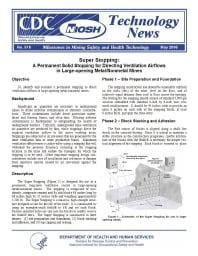Mining Publication: Technology News 518 - Super Stopping: A Permanent Solid Stopping for Directing Ventilation Airflows in Large-opening Metal/Nonmetal Mines
Original creation date: May 2006
Authors: RH Grau
NIOSHTIC2 Number: 20030181
U.S. Department of Health and Human Services, Public Health Service, Centers for Disease Control and Prevention, National Institute for Occupational Safety and Health, DHHS (NIOSH) Publication No. 2006-134, Technology News 518, 2006 May; :1-2
Significant air quantities are necessary in underground mines to dilute airborne contaminants to statutory concentrations. These contaminants include diesel particulate matter, diesel and blasting fumes, and silica dust. Diluting airborne contaminants is fundamental to safeguarding the health of underground workers. Typically, underground mine ventilation air quantities are produced by fans, while stoppings direct the required ventilation airflow to the active working areas. Stoppings are subjected to air pressures that are generated by the mine ventilation fans or stone production blasts. Maximum ventilation effectiveness is achieved by using a stopping that will withstand the pressure dynamics occurring at the stopping location in the mine and endure the time span for which the stopping is to be used. Other important stopping design considerations include ease of installation and resistance to damage from repetitive motion caused by air movement against the stopping. The Super Stopping is designed for use as a permanent, long-term ventilation control in large-opening metal/nonmetal mines. The stopping is composed of low-density, composite cement and fly ash blocks 48 inches long by 48 inches high by 32 inches wide and weighing approximately 1,200 lb. The Super Stopping is a massive, high-strength structure designed to last for the life of the mine. It is constructed by using an extended-reach forklift to lift and set each block. Factory-installed holes are cast into the blocks to readily receive the forklift tines. The Super Stopping is constructed in three phases: (1) site preparation and foundation, (2) block stacking and adhesion, and (3) top capping and sealing.

NIOSHTIC2 Number: 20030181
U.S. Department of Health and Human Services, Public Health Service, Centers for Disease Control and Prevention, National Institute for Occupational Safety and Health, DHHS (NIOSH) Publication No. 2006-134, Technology News 518, 2006 May; :1-2